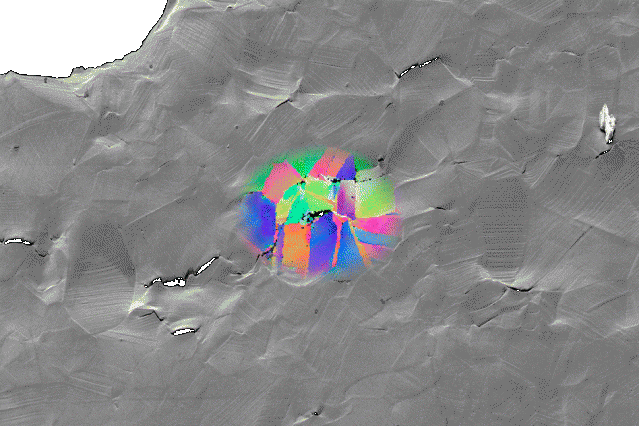 This scanning electron micrograph shows a sample of metal that fractured due to hydrogen embrittlement. The colored patches show data acquired by electron backscatter diffraction, revealing the grain structure surrounding selected cracks. Such images help show the correlation between microstructure and hydrogen embrittlement, and are used to identify the features that lead to hydrogen-assisted fracture. (Credit: John Hanson and Matteo Seita)
This scanning electron micrograph shows a sample of metal that fractured due to hydrogen embrittlement. The colored patches show data acquired by electron backscatter diffraction, revealing the grain structure surrounding selected cracks. Such images help show the correlation between microstructure and hydrogen embrittlement, and are used to identify the features that lead to hydrogen-assisted fracture. (Credit: John Hanson and Matteo Seita)
MIT researchers have carried out a new study into the exact features of a metallic structure which prevents embrittlement in the presence of hydrogen.
This research may be useful to prevent the embrittlement of the metal tube linings of oil wells, which are located several feet below the ocean surface. Due to the higher concentrations of hydrogen beneath the ocean surface, gas penetration into the metal may lead to embrittlement, fractures and leakage. As a result, the metal used in this application needs to be reliable and rigid.
The team at MIT have also observed the basic changes in processing while modifying the structures such that the chances of damages are minimised and the service life of the metal is improved.
The research team includes Michael Demkowicz and Silvija Gradečak, MIT faculty members, John Hanson, a doctoral student in nuclear science and engineering, and materials science and engineering postdoc Matteo Seita.
We want to engineer reliability into the metal.
Michael Demkowicz, Associate Professor of Materials Science and Engineering at MIT
Demkowicz stated that he and his co-workers explored the concept of making materials resistant to damage under harsh conditions. The environment is highly acidic in deep wells. “That means there’s a lot of hydrogen in the environment,” he said. Under such situations, the brittleness of the nickel superalloys employed in deep-well linings tend to increase significantly.
“People have realized for 100 years that metals get brittle when exposed to hydrogen... In fact, most of the materials problems that dog us today are problems that we have known about for a long time: corrosion, fatigue, many different kinds of failure. But we’re still really bad at predicting them,” Demkowicz said.
Considering the critical components like reactor coolant lines and oil-well casings, the metal parts are subjected to prior replacement, for safety, with respect to a worst-case analysis of failure.
The use of more resistant materials or appropriate predictions can ensure prolonged service life of components, resulting in efficient cost-savings. The research team claimed that their findings could significantly avoid frequent replacement of the nickel superalloy in oil drilling operations.
“The novelty of our study was the strategy we used for looking at the microstructure of the material, and what is the role of the microstructure in causing embrittlement,” said Seita, one of the paper’s two lead authors.
Based on the analysis, the researchers observed that the crack in a metal tends to start across the grain boundaries. However, adjusting specific arrangements of these boundaries prevents the development of tiny cracks into larger ones.
As a result, the researchers discovered that both the physical arrangement and grain boundaries play a vital role in determining the extent of susceptibility of the metal to embrittlement.
"Previous investigations had looked at the role of grain boundaries, but only in terms of their overall distribution in the material,” Hanson said. “We had to look at individual grain boundaries, focusing on individual cracks and single grain boundaries.”
Seita claimed that it has been thought that certain special grain boundaries are inherently resistant to fracture. “People thought that introducing more of these would always lead to more resistance, but the story is more complex than that,” he explained.
The researchers observed that a specific type of boundary called a coherent twin boundary (CTB) has a double role in fracture mechanism. CTBs are not involved in the propagation of pre-existing cracks via the metal but are the major factors responsible for the formation of incipient cracks.
This new study was published in the Nature Communications journal.